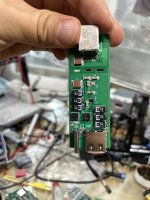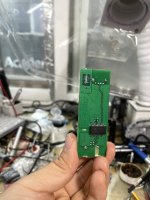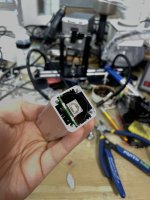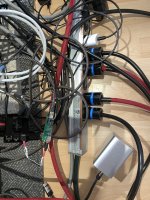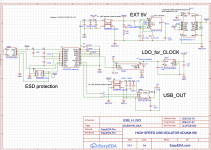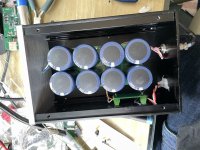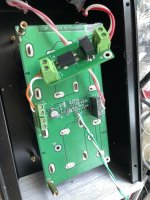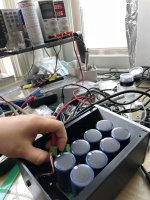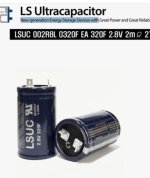I made an isolator board using Analog Device's ADUM4166 chip.
Recently, TI and Analog device both produce isolator chips that support 480Mbps High speed.
TI's chip ISOUSB211 is a redriver, while Analog device's isolator chip ADUM4166 / 4165 is also retimer.
Analog device's isolator is a 24Mhz clock with a RETIMER function that can reset timing jitter.
In effect, the noise of the PC at the front is essentially blocked, and the clock jitter can be resolved by this reclocking isolator.
Considering that there is almost no transmission error although the USB data signal is poor.
It seems to be a fundamental solution to PCfi noise.
I made the cad using EASYEDA .
and orderd from JLCPCB.COM/KOR
in EASYEDA You can check the inventory of parts such as terminals and devices from the manufacturing process.
All parts except the tantalum polymer cap and USB A type terminal were already mounted on the JLCPCB, so it took very little time to make them.
In the case of the optional tantalum polymer, the internal resistance is only 5 milliohms.
I believe it has a lower internal resistance and total impedance than supercap or lithium polymer battery.
The board is an impedance-matched 4-layer board...
I also put an ESD protection element on the input.
The board is designed to minimize the length of stubs that can be created in the USB signal line noise and abnormal transmission.
The clock used is a 2520 size TCXO with a stability level of 0.5ppm. The clock is powered individually by LDO.
The external power supply of 5 volts can be used as a cell phone charger or GAN adapter.
The type C terminal is negated by a pull down resistor on the CC pin.
It can draw up to 5V 3A from a PD charger, so it can be used in professional equipment such as audio interfaces that consume a lot of power.
However, power noise from the charger can enter the DAC.
so I covered it with a common-mode noise filter and tantalum polymer with an extremely low ESR of 5 milliohms.
so that you don't have to worry about the power supply such as battery or linear power as much as possible.
As for the casing, I have a 6cm long aluminum chassis so it fits right in there, I think I'll just have to mill the front and back plates.
I'm testing it between the tinkerboard installed volumio and the AD1865 DAC.
I'm very happy that it worked from the first test^^.
music comes out well.
The effect on sound is easily noticible. I noticed more low bass appeard at first. and more refined mid and highs.
Recently, TI and Analog device both produce isolator chips that support 480Mbps High speed.
TI's chip ISOUSB211 is a redriver, while Analog device's isolator chip ADUM4166 / 4165 is also retimer.
Analog device's isolator is a 24Mhz clock with a RETIMER function that can reset timing jitter.
In effect, the noise of the PC at the front is essentially blocked, and the clock jitter can be resolved by this reclocking isolator.
Considering that there is almost no transmission error although the USB data signal is poor.
It seems to be a fundamental solution to PCfi noise.
I made the cad using EASYEDA .
and orderd from JLCPCB.COM/KOR
in EASYEDA You can check the inventory of parts such as terminals and devices from the manufacturing process.
All parts except the tantalum polymer cap and USB A type terminal were already mounted on the JLCPCB, so it took very little time to make them.
In the case of the optional tantalum polymer, the internal resistance is only 5 milliohms.
I believe it has a lower internal resistance and total impedance than supercap or lithium polymer battery.
The board is an impedance-matched 4-layer board...
I also put an ESD protection element on the input.
The board is designed to minimize the length of stubs that can be created in the USB signal line noise and abnormal transmission.
The clock used is a 2520 size TCXO with a stability level of 0.5ppm. The clock is powered individually by LDO.
The external power supply of 5 volts can be used as a cell phone charger or GAN adapter.
The type C terminal is negated by a pull down resistor on the CC pin.
It can draw up to 5V 3A from a PD charger, so it can be used in professional equipment such as audio interfaces that consume a lot of power.
However, power noise from the charger can enter the DAC.
so I covered it with a common-mode noise filter and tantalum polymer with an extremely low ESR of 5 milliohms.
so that you don't have to worry about the power supply such as battery or linear power as much as possible.
As for the casing, I have a 6cm long aluminum chassis so it fits right in there, I think I'll just have to mill the front and back plates.
I'm testing it between the tinkerboard installed volumio and the AD1865 DAC.
I'm very happy that it worked from the first test^^.
music comes out well.
The effect on sound is easily noticible. I noticed more low bass appeard at first. and more refined mid and highs.
This is complete pcb and testing.
Attachments
I like the board you built: good job!
I use a Digital Transport instead of the PC (or Mac) and a commercial Isolator that uses Adum4160 (of which 4166 is an improvement).
After a quick comparison of 4160 vs 4166 datasheet it seems the differences are related to the number of pin, the High Speed feature (however 12 Mbps at least here are enough), the slightly higher insulation voltage and a new feature to reduce the jitter.
Just as you reported, noticed improvements in SQ me too.
Also I've other isolators using 3160, which apparently has only a lower isolation voltage compared to 4160, but I definitely prefer 4160.
However after seeing your nice work I've not found any commercial isolator that already uses 4166 (except the 4166 evaluation board itself).
I would have two points to (try to) further improve the SQ of your board.
a)
Use an external 5VDC power supply.
My board with 4160 has a DC socket and a related switch by design.
I do not know if with your board it will be possible to do it (if you have not already done it, of course), but if it is possible just as I think then try it: with a good regulated PS you would listen to further improvement in SQ.
I always use external power supply.
b)
Use the upstream connector on your board (USB Type A female) as close as possible to the USB port of your PC.
Better if even without a cable.
If so, it's enough to replace the USB Type A female socket on your bord with a USB Type A male plug, and then connecting it directly to your PC USB port with no cable at all (however not all installations would have room enough to do that).
Try and then listen to.
I use a Digital Transport instead of the PC (or Mac) and a commercial Isolator that uses Adum4160 (of which 4166 is an improvement).
After a quick comparison of 4160 vs 4166 datasheet it seems the differences are related to the number of pin, the High Speed feature (however 12 Mbps at least here are enough), the slightly higher insulation voltage and a new feature to reduce the jitter.
Just as you reported, noticed improvements in SQ me too.
Also I've other isolators using 3160, which apparently has only a lower isolation voltage compared to 4160, but I definitely prefer 4160.
However after seeing your nice work I've not found any commercial isolator that already uses 4166 (except the 4166 evaluation board itself).
I would have two points to (try to) further improve the SQ of your board.
a)
Use an external 5VDC power supply.
My board with 4160 has a DC socket and a related switch by design.
I do not know if with your board it will be possible to do it (if you have not already done it, of course), but if it is possible just as I think then try it: with a good regulated PS you would listen to further improvement in SQ.
I always use external power supply.
b)
Use the upstream connector on your board (USB Type A female) as close as possible to the USB port of your PC.
Better if even without a cable.
If so, it's enough to replace the USB Type A female socket on your bord with a USB Type A male plug, and then connecting it directly to your PC USB port with no cable at all (however not all installations would have room enough to do that).
Try and then listen to.
Last edited:
Thanx for intersesting.
This board has already additional USB type C connector for external power supply. (Beside type A conmector) It can be any phone charger or external battery bank for external power.
Due to cc pin pull down resistor , It can draw 5V 3A from PD power supply. I use Ipad charger now. And It works well.
And another big important difference is that adum4166 has retiming function like USB hub. So compared with old chips which has only redriver function, we do not need to worry about signal integrity and Audio data can be dilevered more stable without inttermittant CRC check, re send inquiries ..
This board has already additional USB type C connector for external power supply. (Beside type A conmector) It can be any phone charger or external battery bank for external power.
Due to cc pin pull down resistor , It can draw 5V 3A from PD power supply. I use Ipad charger now. And It works well.
And another big important difference is that adum4166 has retiming function like USB hub. So compared with old chips which has only redriver function, we do not need to worry about signal integrity and Audio data can be dilevered more stable without inttermittant CRC check, re send inquiries ..
Not exactly.
As I already said the Isolator I use is a commercial (not DIY) product so I've no circuit information at all and also I don't see the sense of deepening the circuit knowledge of a chip (4160) that has been overcome by the most recent 4166.
Actually who should share the circuit details are you.
However I liked to share my experience relating to both external (linear is better IMO) power supply and the nearing to the PC's USB port even without cable because I had good results.
If you want to try, please try and then report your results about SQ.
As said, I've not yet managed to find a commercial Isolator using 4166, but I think that some ones will soon appear and then I'll be able to try the 4166 too.
As I already said the Isolator I use is a commercial (not DIY) product so I've no circuit information at all and also I don't see the sense of deepening the circuit knowledge of a chip (4160) that has been overcome by the most recent 4166.
Actually who should share the circuit details are you.
However I liked to share my experience relating to both external (linear is better IMO) power supply and the nearing to the PC's USB port even without cable because I had good results.
If you want to try, please try and then report your results about SQ.
As said, I've not yet managed to find a commercial Isolator using 4166, but I think that some ones will soon appear and then I'll be able to try the 4166 too.
Why used exactly 4166?
4165 is more suitable for this application.
Also there are 3165/3166, the same things as 4165/4166, but less kilovolts in isolation (doesn't matter) and different package.
I have isolators with TI's ISOUSB211 and AD3165, but last was shipped a month ago - there are no chips now
4165 are available, but requires new PCB design because of it's different package.
4165 is more suitable for this application.
Also there are 3165/3166, the same things as 4165/4166, but less kilovolts in isolation (doesn't matter) and different package.
I have isolators with TI's ISOUSB211 and AD3165, but last was shipped a month ago - there are no chips now
4165 are available, but requires new PCB design because of it's different package.
@samadi81
IMHO, to post about your USB isolator and then not to share any information is kind of teasing people.
You show us your shiny new toy, but not how to make it.
I think as long as you put a disclaimer on your design (cannot fully test USB, build at your own risk, etc) then you're fine to make gerbers and/or pwb source files public.
Just my thoughts and opinions.
Randy
IMHO, to post about your USB isolator and then not to share any information is kind of teasing people.
You show us your shiny new toy, but not how to make it.
I think as long as you put a disclaimer on your design (cannot fully test USB, build at your own risk, etc) then you're fine to make gerbers and/or pwb source files public.
Just my thoughts and opinions.
Randy
Why used exactly 4166?
After a quick comparison of 4160 vs 4166 datasheet it seems the differences are related to the number of pin, the High Speed feature (however 12 Mbps at least here are enough), the slightly higher insulation voltage and a new feature to reduce the jitter.
Why exactly?4165 is more suitable for this application.
Also there are 3165/3166, the same things as 4165/4166, but less kilovolts in isolation (doesn't matter) and different package.
Also I've other isolators using 3160, which apparently has only a lower isolation voltage compared to 4160, but I definitely prefer 4160.
P. S. 1: However never tried 3165/3166.
P. S. 2: Just found the following interesting information from 4165/4166datasheet
https://www.analog.com/media/en/technical-documentation/data-sheets/adum4165-4166.pdf
"The ADuM4165 supports the clock or crystal input on the upstream side, and the ADuM4166 supports the clock or crystal input on the downstream side, offering two options to best suit the system design".
I have to deepen the subject to understand which of the two would be better in my system.
Thank you for your addressing.
Last edited:
It depends of an application. Usually isolator used as Fig. 19 in datasheet.Why exactly?
But of course, using as Fig.20 is also possible. Especially if the isolator is built-in the device (USB-receiver), but in this case I2S isolation is much better and simpler.
BTW, IMHO jitter is not a problem in our application - it mostly depends of a USB-receiver and DAC clocking.
I mentioned Fig 19 and 20 in the datasheet, that describe a different use cases.I have to deepen the subject to understand which of the two would be better in my system.
The main difference is how the secondary part is powered.
My device in both versions (TI and AD) has DC-DC convertor for the secondary, fed from the primary, so my choice was Fig.19 (3165). It is also possible to use external power for the secondary (DC-DC is switched off), in this case both 3165/3166 (or 4165/4156) can be used.
(btw, I have the crystal with 2 caps on both sides of the chip, so is possible to use as 65, as 66, just to solder crystal+caps at the right side).
This is a rough schematic. I'm releasing it under the assumption that it's for DIY purposes only. In fact, this circuit is so easy to make if you have access to the datasheet and the Eval Board manual, I figured that anyone with the drive to make it could make it without my schematic. Since making it from this schematic, I've made some manual modifications to the connection between the connector shield and the ground. Other than that, it's consistent with the schematic;
This works very well, and is very responsive to the quality of the power, especially after isolation;
This works very well, and is very responsive to the quality of the power, especially after isolation;
Attachments
I tested several external power sources: linear, battery and supercapacitor power, which I have already tested elsewhere, and I have my own supercap power supply module. This module is made of 4 pairs of 320F supercapacitors with 2mohm internal resistance connected in parallel to make 5V, so I think it's a good option here, as the power supply has a total internal resistance of 0.5mohm. In terms of sound effects, there is a very deep and detailed bass that I have never heard before;Not exactly.
As I already said the Isolator I use is a commercial (not DIY) product so I've no circuit information at all and also I don't see the sense of deepening the circuit knowledge of a chip (4160) that has been overcome by the most recent 4166.
Actually who should share the circuit details are you.
However I liked to share my experience relating to both external (linear is better IMO) power supply and the nearing to the PC's USB port even without cable because I had good results.
If you want to try, please try and then report your results about SQ.
As said, I've not yet managed to find a commercial Isolator using 4166, but I think that some ones will soon appear and then I'll be able to try the 4166 too.
Attachments
- Home
- Source & Line
- PC Based
- I made a USB highspeed ISOLATOR
